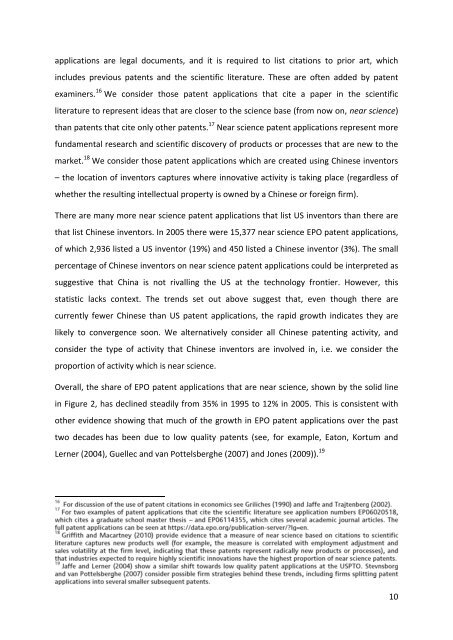Innovation in China - The Institute For Fiscal Studies
Innovation in China - The Institute For Fiscal Studies
Innovation in China - The Institute For Fiscal Studies
Create successful ePaper yourself
Turn your PDF publications into a flip-book with our unique Google optimized e-Paper software.
applications are legal documents, and it is required to list citations to prior art, which<br />
<strong>in</strong>cludes previous patents and the scientific literature. <strong>The</strong>se are often added by patent<br />
exam<strong>in</strong>ers. 16 We consider those patent applications that cite a paper <strong>in</strong> the scientific<br />
literature to represent ideas that are closer to the science base (from now on, near science)<br />
than patents that cite only other patents. 17 Near science patent applications represent more<br />
fundamental research and scientific discovery of products or processes that are new to the<br />
market. 18 We consider those patent applications which are created us<strong>in</strong>g Ch<strong>in</strong>ese <strong>in</strong>ventors<br />
– the location of <strong>in</strong>ventors captures where <strong>in</strong>novative activity is tak<strong>in</strong>g place (regardless of<br />
whether the result<strong>in</strong>g <strong>in</strong>tellectual property is owned by a Ch<strong>in</strong>ese or foreign firm).<br />
<strong>The</strong>re are many more near science patent applications that list US <strong>in</strong>ventors than there are<br />
that list Ch<strong>in</strong>ese <strong>in</strong>ventors. In 2005 there were 15,377 near science EPO patent applications,<br />
of which 2,936 listed a US <strong>in</strong>ventor (19%) and 450 listed a Ch<strong>in</strong>ese <strong>in</strong>ventor (3%). <strong>The</strong> small<br />
percentage of Ch<strong>in</strong>ese <strong>in</strong>ventors on near science patent applications could be <strong>in</strong>terpreted as<br />
suggestive that Ch<strong>in</strong>a is not rivall<strong>in</strong>g the US at the technology frontier. However, this<br />
statistic lacks context. <strong>The</strong> trends set out above suggest that, even though there are<br />
currently fewer Ch<strong>in</strong>ese than US patent applications, the rapid growth <strong>in</strong>dicates they are<br />
likely to convergence soon. We alternatively consider all Ch<strong>in</strong>ese patent<strong>in</strong>g activity, and<br />
consider the type of activity that Ch<strong>in</strong>ese <strong>in</strong>ventors are <strong>in</strong>volved <strong>in</strong>, i.e. we consider the<br />
proportion of activity which is near science.<br />
Overall, the share of EPO patent applications that are near science, shown by the solid l<strong>in</strong>e<br />
<strong>in</strong> Figure 2, has decl<strong>in</strong>ed steadily from 35% <strong>in</strong> 1995 to 12% <strong>in</strong> 2005. This is consistent with<br />
other evidence show<strong>in</strong>g that much of the growth <strong>in</strong> EPO patent applications over the past<br />
two decades has been due to low quality patents (see, for example, Eaton, Kortum and<br />
Lerner (2004), Guellec and van Pottelsberghe (2007) and Jones (2009)). 19<br />
10
















